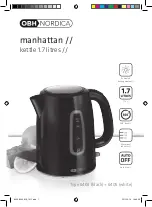
5
English
Boil-dry protection
O
If you switch on with too little
water, your kettle will cut
out automatically. Switch off,
remove from the powerbase
and let it cool down before
re-filling. When it has cooled
down, the switch will reset
itself.
Care and cleaning
O
Before cleaning, unplug your
kettle and let it cool down.
The outside and powerbase
O
Wipe with a damp cloth, then
dry. Do not use abrasives -
they will scratch the metal and
plastic surfaces.
The inside
O
Wipe with bicarbonate of
soda on a damp cloth. Rinse
thoroughly.
O
Even though your kettle
comes with a filter, you still
need to clean the inside (and
the filter) regularly.
The filter
(B)+(C)
1 Open the lid.
2 Unclip and slide out the filter
(B)
.
3
Either
rinse under the tap
or use a soft brush
or
when
descaling your kettle, drop the
filter in too. Rinse thoroughly.
4 Replace the filter by locating
the front of the filter into the
spout area then clip into place
(C)
.
Descaling
O
Regular descaling of the flat
element will improve the
performance of your kettle.
If the kettle is not descaled
regularly the build up of
limescale may result in the
following:
O
problems may be
experienced with the kettle
switching on and off during
use or switching off before
boiling.
O
the kettle may take longer
to boil.
O
the flat element may be
damaged.
Please note: Failure to descale
your kettle may invalidate your
guarantee.
O
When limescale starts to build
up on the heating element,
buy a suitable descaler and
descale your kettle. After
descaling, boil with fresh
water several times and
discard. Clean any descaler off
the kettle - it can damage the
parts.
O
Some regions of the country
have chalky water. This makes
boiled water look cloudy and
leaves a deposit on the side of
the kettle. This is normal but
can be removed with regular
cleaning.
O
Alternatively, to reduce
limescale build up, use filtered
water to fill your kettle.






































